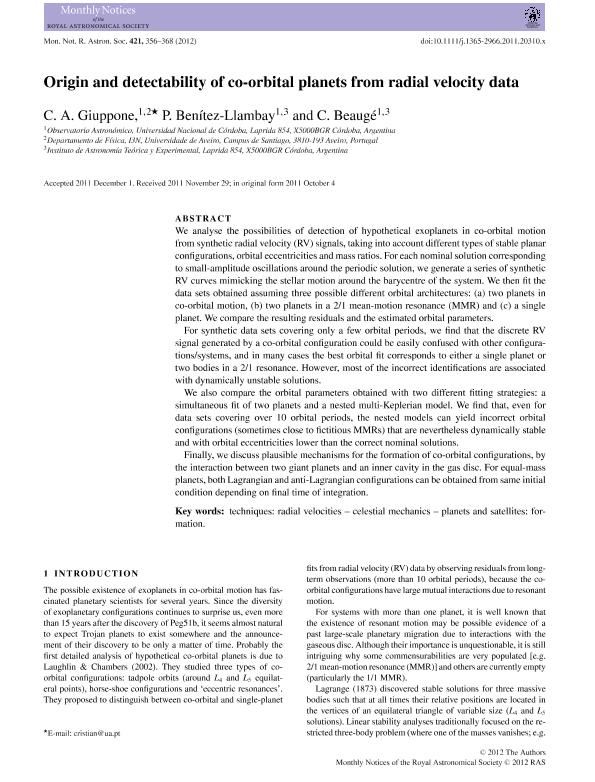Mostrar el registro sencillo del ítem
dc.contributor.author
Giuppone, Cristian Andrés

dc.contributor.author
Benítez Llambay, Pablo

dc.contributor.author
Beauge, Cristian

dc.date.available
2023-05-31T18:01:44Z
dc.date.issued
2012-03
dc.identifier.citation
Giuppone, Cristian Andrés; Benítez Llambay, Pablo; Beauge, Cristian; Origin and detectability of co-orbital planets from radial velocity data; Wiley; Monthly Notices of the Royal Astronomical Society; 421; 3-2012; 356-368
dc.identifier.issn
0035-8711
dc.identifier.uri
http://hdl.handle.net/11336/199195
dc.description.abstract
We analyze the possibilities of detection of hypothetical exoplanets in coorbital motion from synthetic radial velocity (RV) signals, taking into account different types of stable planar configurations, orbital eccentricities and mass ratios. For each nominal solution corresponding to small-amplitude oscillations around the periodic solution, we generate a series of synthetic RV curves mimicking the stellar motion around the barycenter of the system. We then fit the data sets obtained assuming three possible different orbital architectures: (a) two planets in coorbital motion, (b) two planets in a 2/1 mean-motion resonance, and (c) a single planet. We compare the resulting residuals and the estimated orbital parameters. For synthetic data sets covering only a few orbital periods, we find that the discrete radial velocity signal generated by a coorbital configuration could be easily confused with other configurations/systems, and in many cases the best orbital fit corresponds to either a single planet or two bodies in a 2/1 resonance. However, most of the incorrect identifications are associated to dynamically unstable solutions. We also compare the orbital parameters obtained with two different fitting strategies: a simultaneous fit of two planets and a nested multi-Keplerian model. We find that, even for data sets covering over ten orbital periods, the nested models can yield incorrect orbital configurations (sometimes close to fictitious mean-motion resonances) that are nevertheless dynamically stable and with orbital eccentricities lower than the correct nominal solutions. Finally, we discuss plausible mechanisms for the formation of coorbital configurations, by the interaction between two giant planets and an inner cavity in the gas disk. For equal mass planets, both Lagrangian and anti-Lagrangian configurations can be obtained from same initial condition depending on final time of integration.
dc.format
application/pdf
dc.language.iso
eng
dc.publisher
Wiley

dc.rights
info:eu-repo/semantics/openAccess
dc.rights.uri
https://creativecommons.org/licenses/by-nc-sa/2.5/ar/
dc.subject
CELESTIAL MECHANICS
dc.subject
PLANETS AND SATELLITES: GENERAL
dc.subject
PLANETS AND SATELLITES: ORIGIN
dc.subject.classification
Astronomía

dc.subject.classification
Ciencias Físicas

dc.subject.classification
CIENCIAS NATURALES Y EXACTAS

dc.title
Origin and detectability of co-orbital planets from radial velocity data
dc.type
info:eu-repo/semantics/article
dc.type
info:ar-repo/semantics/artículo
dc.type
info:eu-repo/semantics/publishedVersion
dc.date.updated
2023-05-30T11:51:02Z
dc.identifier.eissn
1365-2966
dc.journal.volume
421
dc.journal.pagination
356-368
dc.journal.pais
Reino Unido

dc.description.fil
Fil: Giuppone, Cristian Andrés. Universidade de Aveiro; Portugal. Observatorio Astronomico de la Universidad Nacional de Cordoba; Argentina. Consejo Nacional de Investigaciones Científicas y Técnicas. Centro Científico Tecnológico Conicet - Córdoba. Instituto de Astronomía Teórica y Experimental. Universidad Nacional de Córdoba. Observatorio Astronómico de Córdoba. Instituto de Astronomía Teórica y Experimental; Argentina
dc.description.fil
Fil: Benítez Llambay, Pablo. Observatorio Astronomico de la Universidad Nacional de Cordoba; Argentina. Consejo Nacional de Investigaciones Científicas y Técnicas. Centro Científico Tecnológico Conicet - Córdoba. Instituto de Astronomía Teórica y Experimental. Universidad Nacional de Córdoba. Observatorio Astronómico de Córdoba. Instituto de Astronomía Teórica y Experimental; Argentina
dc.description.fil
Fil: Beauge, Cristian. Observatorio Astronomico de la Universidad Nacional de Cordoba; Argentina. Consejo Nacional de Investigaciones Científicas y Técnicas. Centro Científico Tecnológico Conicet - Córdoba. Instituto de Astronomía Teórica y Experimental. Universidad Nacional de Córdoba. Observatorio Astronómico de Córdoba. Instituto de Astronomía Teórica y Experimental; Argentina
dc.journal.title
Monthly Notices of the Royal Astronomical Society
dc.relation.alternativeid
info:eu-repo/semantics/altIdentifier/url/http://onlinelibrary.wiley.com/doi/10.1111/j.1365-2966.2011.20310.x/full
dc.relation.alternativeid
info:eu-repo/semantics/altIdentifier/doi/http://dx.doi.org/10.1111/j.1365-2966.2011.20310.x
Archivos asociados
